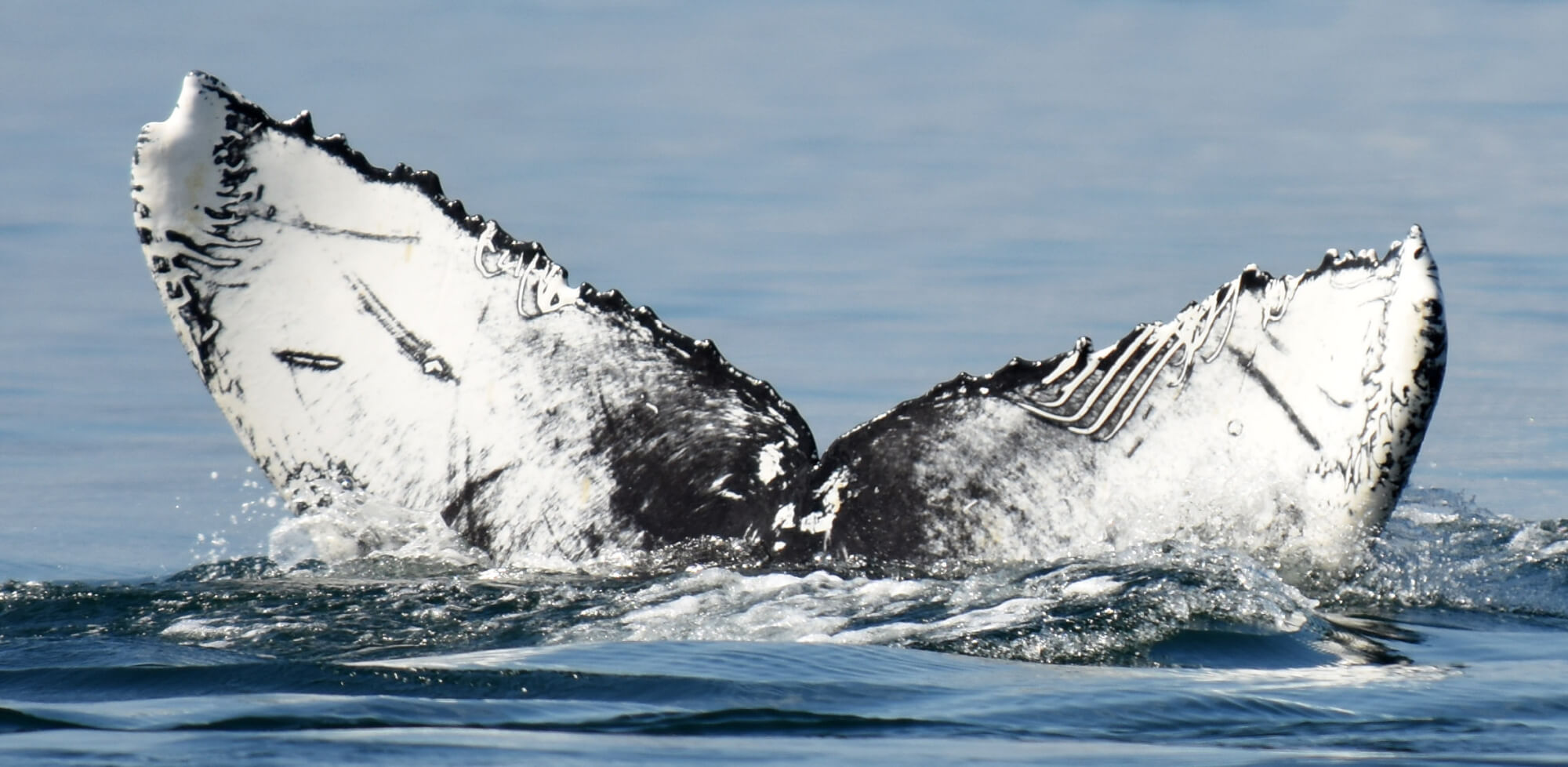Chewbacca
Humpback Whale


-
ID number
H824
-
Sex
Female
-
Year of birth
2015
-
Known Since
2015
Distinctive traits
H824 is a humpback whale that is easy to spot, thanks to her uniquely patterned tail flukes. Her tail is mostly white, with the exception of the centre (where the two lobes meet), where one can observe a black section that fades as it moves away from the centre. Four smaller white spots mark the middle of this spot. Her left fluke is “clipped” at the tip, and rake marks can be seen on the tip of the right fluke (first identified in 2016). These marks are the result of a killer whale attack. The tips of her two flukes are completely white, bordered by a wavy black outline. She also shows an X on her left lobe.
Observations history in the Estuary
Years in which the animal was not observed Years in which the animal was observed
Latest news from the publications Portrait de baleines
From a very young age, Chewbacca would have been confronted with one of the rare predators of humpback whales: the orca. She kept remarkable scars on her tail fin. René Roy, from the Mingan Island Cetacean Research Station (MICS), observed this whale for the first time in the Gulf of St. Lawrence in 2015. Chewbacca was only six months old at the time, but already bore the after-effects of this attack: a cut left lobe and tooth marks (parallel lines like a rake mark). Although it is rare for orcas to hunt large whales, some populations do attack calves during their first migration, between the southern breeding grounds and the northern feeding grounds. These attacks are sometimes fatal. Fortunately, thanks to the powerful flippers of her mother Quill, Chewbacca survived this aggression and managed to reach the waters of the St. Lawrence. The young whale then became a “regular” in the estuary in 2016. Then named H824, she was renamed “Chewbacca” in 2019 by MICS following a popular vote. Her name refers to the bite marks that this misadventure left her as a souvenir.
Following a vote on Facebook, the team at the Mingan Islands Research Station named humpback whale H824 Chewbacca. The public’s choice of name was obviously influenced by the killer whale’s teeth marks.
H824 is a humpback whale that is easy to spot, thanks to her uniquely patterned tail flukes. Her tail is mostly white, with the exception of the centre (where the two lobes meet), where one can observe a black section that fades as it moves away from the centre. Four smaller white spots mark the middle of this spot. Her left fluke is “clipped” at the tip, and rake marks can be seen on the tip of the right fluke (first identified in 2016). These marks are the result of a killer whale attack. The tips of hertwo flukes are completely white, bordered by a wavy black outline. She also shows an X on her left lobe. The Mingan Island Cetacean Study (MICS) first sighted H824 with her mother Quill in 2015 (the year she was born). This year, Quill was photo-ID’d by GREMM research assistants on September 1.
Killer whales most often go after calves and not adults. Killer whale attacks on baleen whales in the northwest Atlantic are evident by the parallel lines left by the teeth of these predators. These marks are especially present on the pectoral fins and the tail, which killer whales grip in order to control their prey. Attacks on calves occur mainly during their first migration to the feeding grounds from their warm-water birthing grounds. Generally the northward migration begins when the calves are just a few months old.
Some studies suggest that killer whale predation on baleen whales may have contributed to the evolution of migration in these species. The breeding grounds of humpbacks are generally far away from killer whale feeding areas. In the case of adults, killer whales rarely hunt large rorquals such as blue whales, humpbacks or fin whales, but they can on occasion. Killer whales, however, seem to prefer smaller marine mammals (calves, minke whales, dolphins, pinnipeds, etc.) and these preferences vary depending on where the individuals are and which population they belong to. Some have a penchant for minke whales while other populations prefer to feed on seals or sea lions. Additionally, not all killer whale populations feed on marine mammals; some populations feed exclusively on fish. In British Columbia, the Resident Killer Whales feed almost exclusively on a single species, the king salmon (or chinook salmon), even if other species such as sockeye salmon are more abundant.
